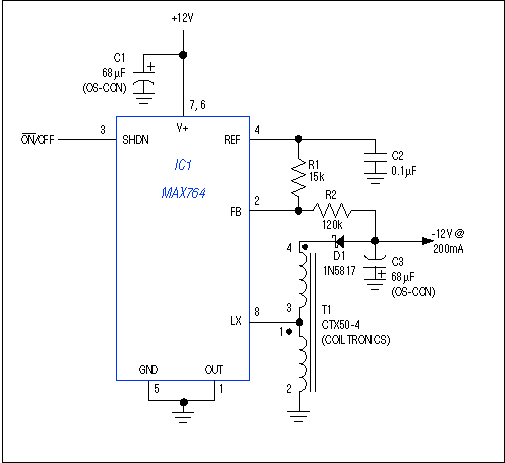Autotransformer Regulator Inverts 12V to -12V
Abstract
The autotransformer provides an alternative means of extending the output voltage range of an inverting DC-DC regulator besides using an external MOSFET or a flyback transformer. With an autotransformer, the input-output voltage can be extended beyond the specification limit of the integrated circuit (IC).
In Figure 1, a dc-dc regulator with internal switching MOSFET inverts 12V to produce an output of 200mA at -12V. The IC is a high-efficiency device whose low quiescent current (120µA maximum) is achieved with a CMOS process that limits the absolute maximum voltage to 21V (input to output). Thus, to avoid 24V across its terminals, the IC must isolate itself from the inductor-flyback voltage by driving either an external switch in a non-bootstrapped configuration, or an internal switch in a flyback-transformer configuration.

Figure 1. Autotransformer T1 limits the voltage across IC1, allowing use of a high-efficiency chip (with 21V absolute-maximum voltage) in this inverting dc-dc regulator.
Autotransformer T1 (a center-tapped inductor with 1:1 turns ratio) offers a design alternative. In the circuit shown, LX flies back to 1/2VOUT plus a diode drop, or approximately -6V. V+ remains at 12V, producing an 18V maximum between V+ and LX that is well within the 21V limit.
Because IC1 drives the gate of its internal MOSFET between the V+ and OUT voltages, you normally connect OUT to VOUT to ensure sufficient gate drive (in a typical application, the chip inverts 5V to -5V). In this circuit the 12V input provides adequate gate drive, so OUT is connected to ground.